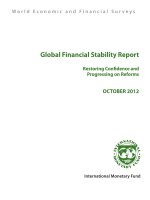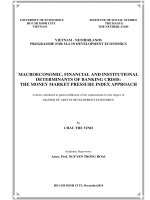Report Môn financial and banking
Bạn đang xem bản rút gọn của tài liệu. Xem và tải ngay bản đầy đủ của tài liệu tại đây (785.17 KB, 18 trang )
COLLEGE: ĐONG A UNIVERSITY
DEPARTMENT: FINANCIAL - ACCOUNTING
REPORT
ENGLISH FOR FINANCE & BANKING
Major
Lecturer
Member
Class
Finance and Banking
Dương Công Danh
Huỳnh Tấn Triệu (Leader)
Phan Phạm Thanh Xuân
Nguyễn Thị Vui
Nguyễn Minh Thư
Thân Hoàng Tú Như
FB20A1A
Đà Nẵng, Dec 2022
Major
Finance and Banking
MỤC LỤC
I. SAMSUNG COMPANY PROFILE....................................................................................3
1. Company information........................................................................................................3
2. Featured products...............................................................................................................3
3. Samsung's corporate strategy 2022 and 2023....................................................................3
4. Market share.......................................................................................................................4
II. FINANCIAL RATIOS........................................................................................................4
III. RATIO ANALYSIS TO FORECAST..............................................................................7
1. Analysis...............................................................................................................................7
2. Forecast estimate.................................................................................................................7
IV. COMPETITORS ANALYSIS...........................................................................................9
1. Apple...................................................................................................................................9
1.1. Corporate informations................................................................................................9
1.2. About products.............................................................................................................9
1.3. Market share and Valuable Brands............................................................................10
1.4. About revenue............................................................................................................10
2. Sony..................................................................................................................................11
2.1. Corporate informations..............................................................................................11
2.2. Major Products...........................................................................................................11
2.3. Maket share................................................................................................................12
2.4. Revenue......................................................................................................................12
V. CONCLUSION...................................................................................................................12
1. Samsung's strengths..........................................................................................................12
1.1. Brand valuation..........................................................................................................12
1.2. Dominates the Smartphone Market...........................................................................13
1.3. Award Winning Brand...............................................................................................13
1.4. Ecologically Friendly Innovations.............................................................................13
1.5. Market leader in televisions, LCD screens................................................................13
1.6. Diversified Portfolio..................................................................................................13
1.7. Asia's market leader...................................................................................................14
1.8. Extensive distribution network..................................................................................14
2. Development plan.............................................................................................................14
2.1. Samsung's Global Strategy........................................................................................14
2.2. Samsung's Transnational Strategy.............................................................................15
3. Samsung’s Opportunities..................................................................................................15
3.1. Triple Protection Proposition.....................................................................................15
3.2. HR Management........................................................................................................15
3.3. Diversification and Acquisitions................................................................................15
3.4. Introduce Innovative Products...................................................................................15
3.5. 5G Technology...........................................................................................................16
3.6. Samsung Makes Powerful Processor for Next-Gen Smartphone Gaming................16
4. Samsung’s Threats............................................................................................................16
4.1. Patent Infringement Controversies............................................................................16
4.2. Increased Competition...............................................................................................16
4.3. Legal and Regulatory Threats....................................................................................16
4.4. Economic Uncertainty...............................................................................................16
4.5. Rise of Counterfeiting................................................................................................16
4.6. Impending Court Cases..............................................................................................17
4.7. Dissatisfied Phone Users............................................................................................17
4.8. LG’s Foldable Display Technology May Surpass Samsung.....................................17
VI. REFERENCE MATERIAL............................................................................................17
2
I.
SAMSUNG COMPANY PROFILE
1. Company information
Samsung was founded by Lee Byung-chul in 1938 as a trading company.
Samsung, South Korean company that is one of the world’s largest producers of
electronic devices. Samsung specializes in the production of a wide variety of
consumer and industry electronics, including appliances, digital media devices,
semiconductors, memory chips, and integrated systems. It has become one of the
most-recognizable names in technology and produces about a fifth of South Korea’s
total exports
.
2. Featured products
In 2019, Samsung celebrated 50 years since its inception, offered the world's first
8K HDR10 + content, launched their first foldable phone in 2019 and is called
Samsung Galaxy Fold.
In 2020, launched Samsung Z Flip is the first phone with a foldable glass screen
In 2021, Launched Galaxy S21 series, Galaxy Buds Pro
In 2022, Galaxy Unpacked 2022 event: Samsung launches Z Fold 4, Z Flip 4,
Galaxy Watch 5
3. Samsung's corporate strategy 2022 and 2023
Samsung Electronics today reported financial results for the third quarter
ended September 30, 2022.
Total consolidated revenue was a record for the third-quarter at KRW 76.78
trillion despite a challenging business environment, while operating profit declined
23% from the previous quarter to KRW 10.85 trillion. With record revenue in each
of the respective quarters so far this year, the Company expects annual revenue to
surpass the historical high set in 2021.
In 2023, demand is expected to recover to some extent, but macroeconomic
uncertainties are likely to persist. The DS (Device Solutions) Division plans to
actively address demand for high-density products and expand contributions from
advanced nodes and adoption of new applications. The DX (Device eXperience)
Division will continue to strengthen the leadership in premium segments and
enhance the multi-device connectivity experience across mobile, TVs and home
appliances
SDC expects to maintain earnings growth in the mobile panel business, driven
by strong demand for premium OLED panels for smartphones. The large panel
business will expand the quantum-dot (QD)-OLED presence, increasing its
customer base.
3
Mobile Display Earnings Improve; Large Display To Continue QD-OLED
Expansion
- In 2023, while macroeconomic challenges may persist, Samsung will focus
on solid earnings through pre-emptive investments, development of differentiated
technologies and effective management to ensure stable quality and yield. Also, the
Company will collaborate more closely with customers to increase its OLED market
share, promoting the advantages of OLED in new application areas such as IT,
Automotive and Gaming.
- Flagship Sales Drive Mobile Profit; To Seek Revenue Growth and Solid
Profitability in 2023
In particular, in the AR/VR market, which is projected to enjoy full-fledged
growth starting 2023, Samsung will develop the technologies that customers need
and complete SCM in order to solidify its leadership in the display industry.
4.
Market share
- Samsung has been a consistent front-row competitor in the global smartphone
market. In the third quarter of 2022, Samsung held a global smartphone market share
of 22 percent.
- Samsung retained its leading position with a 22% market share driven by heavy
promotions to reduce channel inventory.
- Samsung's new product models such as the Galaxy Note 20, Galaxy Z Fold 2
and Galaxy Z Flip foldable phones have helped its phone sales increase sharply in the
domestic market in the third quarter. In the fourth quarter of this year, Samsung's
market share is expected to decrease slightly due to increased market demand for
Apple's newly launched iPhone 12 model, which was sold in the Korean market on
October 30.
II. FINANCIAL RATIOS
4
Targets
UNIT: 1 million
Caculating Method
2019
2020
PROFITABILITY OR RETURN ON INVESTMENT RATIONS
(83.161/230.400)*100
(92.318/236.806)*100
Gross Profit / Net Sales
= 36,1%
= 39,0%
(21.505/230.400)*100
(26.090/236.806)*100
Net Income / Net Sales
= 9,3%
= 10,1%
(21.505/352.564)*100
(26.090/378.235)*100
Net Income / Total Assets
= 6,1%
= 6,9%
(21.505/254.915)*100
(26.090/276.670)*100
= Net Income / Owners' Equity
= 8,4%
=9,7%
1
Gross Profitability
2
Net Profitability
3
Return on assets
4
Return on investment 1
5
Return on investment 2
= Net income / Investment
6
Earnings per share
= Net Income / Number of Shares Ourstanding
7
Investment turnover
= Net Sales / Total Assets
8
Sales per employee
= Total Sales / Number of Employee
9
Current ratio
Current Assets/Current Liabilities
10
Quick ratio (or "acid test")
Quick Assets / Current Liabilities
=(Current Assets - Inventory) /
Current Liabilities
11
Cash to total assets
Cash/Total Assets
12
Sales to receivables
(or turnover ratio)
Net Sales/Accounts Receivable
13
Days' receivables ratio
365/Sales to receivables ratio
14
Cost of sales to payables
Cost of Sales/Trade Payables
21.505/5.970 = 3,6
2021
(113.19/279.604)*100
= 40,5%
(39.243/270.604)*100
= 14,0%
(39.243/426.237)*100
= 9,2%
(39.243/296.237)*100
= 13,2%
26.090/5.969 = 4,4
39.243/5.969 = 6,6
(26.090/5,969)
=4.370,5
(236.806/378.235)*100
=63,1%
(378.235/0,10949)
= 3.454.516,4
(39.243/5,969)
=6.573,7
(279.604/426.621)*100
=65,5%
(426.237/0,11349)
=3.755.722
(198.215/75.604)
=2,62
(218.163/88.117)
=2,48
((181.385-26.766)/63.782)
=2,42
((198.215-32.043)/75.604)
=2,2
((218.163-41.384)/ 88.117)
=2,01
(39.031/426.621)
=0,08
(230.400/39.310)
=5.861,1
(365/ 5.861,1)
=0,06
(21.849 / 2.184)
= 10,0%
(29.382/378.235)
=0,08
(236.806/34.569)
= 6.850,2
(365 / 6.850,2)
=0,05
(21.396 / 1.682)
=12,71%
(26.885/352.564)
=0,09
(279.604/45.210)
= 6.184,5
(365/ 6.184,5)
=0,06
(24.687 / 2.991)
=8,25
(21.505/5,970)
= 3.602,1
(230.400/352.564)*100
=65,3%
(352.564/0,10526)
= 3.349.458,5
LIQUIDITY RATIOS
(181.385/63.782)
=2,84
5
(230.400/117.602)
=1.96
LEVERAGE RATIOS
(18.412/254.915)*100
Debt / Owners' Equity
=7,2%
(18.412/352.564)*(100)
Debt / Total Assets
=5,2%
(119.825/234.211)*100
Net Fixed Assets / Tangible Net Worth
=51,2%
(Earnings before Interest +Taxes) /
(30.432/686)
Interest Expense
= 44,24
EFFICIENCY RATIOS
15
Cash turnover
Net Sales/Net Working Capital
16
Debt to equity ratio
17
Debt ratio
18
Fixed to worth ratio
19
Interest coverage
20
Annual inventory turnover
Cost of Goods Sold for the Year/Average
Inventory
21
Inventory holding period
365/Annual Inventory Turnover
22
Inventory to assets ratio
Inventory/Total Assets
23
Accounts receivable
turnover (credit)
Net Sales/Average Accounts Receivable
(26.766/352.564)*100
= 7,59%
(236.806/122.611)
=1,93
(279.604/130.046)
=2,15
(20.217/267.670)*100
=7,56%
(20.217/378.235)*100
=5,3%
(128.952/ 249.201)*100
=51,7%
(36.345/583)
= 62,34
(18.392/296.237)
=6,2%
(18.392/426.612)*100
=4,3%
(149.928/276.001)*100
=54,3%
(53.351/431)
=124,6
(144.488/ ((32.043+26.766)/
2))
= 4,91
(365/4,91)
= 74,28
(32.043/378.235)*100
= 8,47%
(236.806 / ( (1.741 + 1.828)/
2)
=236.806 / 1.784,5
=132,7
(166.411/((41.384+32.043)/2))
= 4,53
(365/ 4,53)
=80,53
(41.384/426.621)*100
= 9,7%
(279.604 / ( (-7.506) + 1.741)/
2)
= 279.604 / (-2.882,5)
= -97,0
6
III. RATIO ANALYSIS TO FORECAST
1. Analysis
Return on assets
Current ratio
Debt to equity
Inventory to assets ratio
2019
6,1%
2,84
5,20%
0,08
2020
6,9%
2,62
5,30%
0,085
2021
9,2%
2,48
4,30%
0,097
2022F
11,3%
2,32
3,9%
0,107
2023F
14,5%
2,18
3,4%
0,120
* Return on Assets (ROA):
In general, ROA from 2019 to 2021 increased, specifically from 6.1% to 9.2%
showing that Company has a high return on assets then the company is less assetintensive. A higher ratio is more appealing to investors since it demonstrates that the
company is better at managing its assets to generate more net income. A rising return
on assets signifies that the company is gaining profits with each Won invested.
It proves that the efficiency of the company's asset exploitation is improving
day by day.
* Current ratio:
The current ratio for three years is greater than 2, showing that the company's
current assets are larger than its current liabilities. However, this ratio tends to
decrease from 2.84 to 2.48 because the strong outbreak of the epidemic in 2019 and
2020 has affected the company's performance, but the company still has the ability to
pay the bills. This ratio is decreasing, indicating a high level of debt repayment by the
company. By 2021, this coefficient drops to 2.48 showing that safe investments are
still put to good use in the business because the current ratio is generally between 1
and 3 for healthy businesses.
Samsung company still be able to more likely to meet its liabilities in 12
months.
* Debt to equity ratio:
The debt to equity ratio represents the capital a business has raised from lending
to its equity, and it is used to gauge a company's financial leverage. This ratio is less
than 1, from 5.2% down to 4.3% showing that the company's financial capacity is
strong. In addition, a low ratio also shows that the company's capital for operations
comes from abundant equity, low debt, not under much financial pressure, and is doing
business effectively.
Therefore, the debt to equity ratio of the company is considered safe because
the company managed debt risk and financial leverage quite well.
* Inventory to assets ratio:
This ratio over the past 3 years tends to increase from 7.59% in 2019 to 9.7% in
2021. It shows that inventories over the past 3 years have increased assets have also
increased. The increase in inventory has had a great impact on this ratio, so an increase
in the inventory to assets ratio has a negative impact on the business performance of
Samsung Group.
Generally, the company should put in place appropriate policies to manage
inventory more effectively.
7
2. Forecast estimate
Image 3.1
Image 3.2
Image 3.3
*Return on assets: It is forecasted that ROA will continue to increase in the Image 3.4
next two years because Samsung is launching many products such as chips,
smartphones, and computers... It has a strong impact on the company's income, total
assets, and net profit in the next two years will increase, leading to an increase in
return on assets.
The very effective management company.
*Current ratio: Regarding current solvency, the next two years are forecast to
have a downward trend, but this ratio is still greater than 1, indicating that the
corporation has enough capital to pay short-term debts and it has no liquidity concerns
about short-term accounts.
The company's ability to pay short-term debts is quite good.
*Debt to equity ratio: In the next two years, the debt-to-equity forecast tends to
decrease, showing that corporate capital from equity is abundant, with little external
debt, is not under much financial pressure, and is doing business effectively.
The company has a leadership department to operate business operations
and manage debt well.
8
*Inventory to assets ratio: The ratio of inventory to assets increases over the
years, so it is forecasted that this ratio will continue to increase in the next 2 years
because in our opinion the total inventory increase has a great impact on the total
assets of the company and this ratio will also affect other ratios.
Impact on the company's business performance in the following years.
Conclusion: The above indicators partly reflect the business performance of
Samsung. In addition, we also make forecasts for the next two years to get these
objective forecast ratios. We find that the company has a lot of diverse and unique
products, stores are located in many countries in the world, experienced management
board and famous corporate brand, high reputation in many countries.
IV. COMPETITORS ANALYSIS
1. Apple
1.1
Corporate informations
CEO: Tim Cook
Headquarters: Cupertino, California
Sector(s): Technology
Industry: Consumer Electronics
Full Time Employees: 164,000
It is considered one of the Big Four technology companies, alongside Amazon,
Google, and Microsoft.
1.2 About products
Some outstanding products launched by Apple can be mentioned as:
- iPhone: iPhone 12 (Pro, Pro Max); iPhone 13 (Pro, Pro Max) (2021)
- Computer: MacBook Air (M1 chip, 2020 launch), MacBook Pro (M1 chip, late
2020), MacBook Air 2020 Intel chip version
In the financial report, Apple announced revenue from iPhone reached 42.6
billion USD, increased 9.7% year-over-year
Some of the widest selling Smartphone series belongs to Samsung. These are the
Samsung Note series, the Samsung Galaxy series as well as the Galaxy Edge series.
iPhone 13 Pro Max and Samsung Galaxy Z Fold3 are the two "horses" of the two
giants Apple and Samsung. Samsung Galaxy Z Fold3 achieved sales of 2.5 million Z
Fold3 units in 2021
9
1.3 Market share and Valuable Brands
iPhone market share in Q3/2022 increased sharply compared to Android
competitor.
Apple reaches 18% of the global market share, increaseed 3% year-on-year.
Meanwhile, Samsung reaches 22% of the global market share, increased from 21% to
22%, The above results help to reduce the market share gap between Apple and
Samsung in the last quarter from 6% to 4%.
Apple Iphone has the lions share of Smartphones in US and it is second highest
market share holder worldwide and is one of the strongest Samsung competitors in the
business.
Gap between Apple and Samsung in Q3/ 2022.
The Most Valuable Brands
Apple retains its top spot on the ranking as the world’s most valuable brand with
a total brand value of $335.1 billion.
Samsung Group ranking 6 with brand value with a total brand value of $107.3
billion.
1.4 About revenue
Apple Revenue 2019-2022
Apple revenue for the twelve months ending September 30, 2022
was $394.328B, a 7.79% increase year-over-year.
Apple annual revenue for 2022 was $394.328B, a 7.79% increase from 2021.
Apple annual revenue for 2021 was $365.817B, a 33.26% increase from 2020.
Apple annual revenue for 2020 was $274.515B, a 5.51% increase from 2019.
In the financial report of Q3/2022, Apple achieved revenue of 83 billion and
profit of 19.4 billion USD
10
Earnings per share reached 1.2 USD in the quarter.
Apple's revenue grew 8.1% to $90.1 billion in the Q3. The Conglomerate's net
profit during this period also reached a record of 20.7 billion USD.
The iPhone was the flagship product line, accounting for nearly half of total sales
this quarter
Apple’s revenue by product category in Q3/2022:
• iPhone: 40.67 billion USD (Increased 3% y-o-y).
• Mac: 7.38 billion USD (decrease 10% y-o-y).
• iPad: USD 7.22 billion (decrease 1.9%).
The number of active iPhones grows year by year
Revenue for Samsung
Revenue in 2022 (TTM):
According to Samsung's latest financial reports the company's current revenue
(TTM) is $241.60 B. In 2021 the company made a revenue of $240.71 B an increase
over the years 2020 revenue that were of $203.43 B.
Because their mobile device business is selling well. It comes from folding
phones like the Samsung Galaxy Z Fold 4 and Z Flip 4, or the Galaxy Watch and
Galaxy Buds.
2. Sony
2.1 Corporate informations
CEO: Yoshida Kenichiro
Headquarters:Minato-Ku,Tokyo,
Japan.
No. of Employees: 108,900
Sector(s): Technology
Industry: Consumer Electronics
2.2 Major Products
Sony's key products include:
11
TV products: Sony is a leading brand in the production of TVs and other
products like projectors, music players, DVD players, cameras, music systems,
PlayStation: Games & Network Services...
PlayStation is the worldwide market leader in the gaming console segment. Sony
offers products that appeal to a wide range of customers. Sony is in the high-end
segment for audio equipment products. Sony laptops are priced in the mid-range
segment. Game Consoles, on the other hand, are in the high-end segment.
2.3 Maket share
In which, Samsung holds the largest share, Samsung leads with 31.5% of the
global TV market share and Sony holds 7.4% of the market share.
In the premium TV segment, with TVs priced at $2,500 or more, Samsung
dominates 53.6% of the global market, Sony with 17.2%.
2.4 Revenue
Sony Revenue 2019-2022
Sony revenue for the twelve months ending September 30, 2022
was $83.815B, a 5.31% decline year-over-year.
Sony annual revenue for 2022 was $88.301B, a 4.38% increase from 2021.
Sony annual revenue for 2021 was $84.594B, a 11.32% increase from 2020.
Sony annual revenue for 2020 was $75.991B, a 2.56% decline from 2019.
Revenue in 2022 (TTM):
According to Sony's latest financial reports the company's current revenue
(TTM) is $80.87 B. In 2021 the company made a revenue of $87.80 B an increase
over the years 2020 revenue that were of $79.84 B.
Sony obtains the best-ever revenue for the fiscal year 2021-2022 due to
results good in film, electronics and music.
V. CONCLUSION
1. Samsung's strengths
1.1. Brand valuation
In 2019, this brand value reached 53.1 billion USD (up 11% compared to 2018).
By 2020 this figure is $ 209.5 billion and puts Samsung in the Top 10 Most Valuable
12
Brands in the world in the field of technology on the Forbes report. Samsung ranks 5
position by Interbrand in 2021 – with a brand value of $74.6 billion. By 2022 Samsung
Group ranking 6 with brand value with a total brand value of $107.3 billion.
The Most Valuable Brands in 2022
In addition to focusing on improving quality, product design and modern
technology application, Samsung also focuses on responsible business practices (CSR)
to maintain an environmentally and socially friendly brand image. Therefore, Samsung
has always been solid and received the love of many users despite the appearance of
new phone brands.
1.2. Dominates the Smartphone Market
Samsung has dominated the smartphone market for years. According to 2021
report by Gartner, Samsung has maintained the No. 1 spot globally with a 19% market
share in smartphone sales, whereas Apple is in the second spot with 16.7% market
share and Xiaomi in the third spot with a 13.2 % market share.
1.3. Award Winning Brand
Samsung’s position as a pioneer for innovation is backed with credibility.
Samsung has won many awards for its products. Samsung has been awarded the CES
(Consumer Electronics Show) owing to its product designs and innovation for many
years.
It went on to receive 43 CES awards in 2022. Moreover, It secured 48 awards at
the International Design Excellence Awards (IDEA).
1.4. Ecologically Friendly Innovations
Samsung has enhanced its brand reputation through its environmentally
friendly innovations. It secured its ranking at 8th position in the Top 30 Tech and
Telecom companies of the Environmental Protection Agency (EPA) 2022 Green
Power.
It also received a rare ENERGY STAR Corporate Commitment Award.
Samsung’s product efficiency has saved approximately 270 million metric tons CO2
emissions worldwide since 2009. Other companies do not share this achievement and
hence increases Samsung’s appeal across all business units.
1.5. Market leader in televisions, LCD screens
In addition to leading the smartphone market share mentioned above, Samsung
has continuously maintained its leading position in the industry with products that
meet consumer needs. Although in recent years, the market share of enterprises has
declined somewhat (20% fell to 17% in 2019), Samsung still holds the leading position
in the industry and is the largest LCD panel manufacturer in the world.
1.6. Diversified Portfolio
Samsung has a very diversified portfolio, and it operates four divisions:
13
Consumer Electronics – represents about 20% of total revenue. The division
sells home electric appliances such as TV, washing machines, air conditioner,
monitors, and refrigerators.
Information technology & Mobile communications – represents about 39%
of total revenue. The division has products such as smartphones, network systems, and
computers.
Device Solutions – is the largest division of Samsung and accounts for about
45% of total revenue. It consists of two sub-divisions: Semiconductor (75% of
divisional revenue) and Display Products (25% of divisional revenue). Products sold in
this division include DRAM, NAND flash, mobile AP, mobile OLED panels, LCD
panels, and semiconductor-related products.
Harman – was acquired by Samsung in 2017 and represents 4% of total
revenue. Harman manufactures and sells digital cockpit, telematics, and speakers.
1.7. Asia's market leader
Samsung is not only a domestic brand loved by domestic consumers but also a
brand trusted by many countries in Asia. The most prominent of which is the world's
leading densely populated market is India.
To achieve the current achievements, Samsung always strives to implement sales
and customer care policies to bring the best experience to users. As a result, the annual
consumption of the business is always stable and makes Samsung a leading giant in
the industry.
1.8. Extensive distribution network
Currently, consumers can easily buy Samsung products at phone stores, brand
centers, genuine stores or order online ... throughout the provinces. Such a wide
distribution network partly speaks of the spread and growth of the world's leading
electronics brand – Samsung.
2.
Development plan
2.1 Samsung's Global Strategy
A global strategy is a competitive strategy aimed at increasing profits on a costcutting basis on a global scale. This is a popular strategy for businesses dealing in
standardized products, competing mainly based on cost – price such as electronic
components, semiconductors, semi-finished products ... Businesses pursuing a global
strategy often launch the same products and use the same marketing strategy across all
markets.
Samsung's international business strategy allows each Samsung subsidiary to be
responsible for delivering services or products to local customers' production lines.
14
The proof of Samsung's global strategy lies in its flagship smartphone, the "Galaxy."
The Galaxy is available in almost every country with uniform specs and features,
regardless of that country's needs.
With its global strategy, Samsung was able to save costs due to standardized
products and using the samemarketing strategy.
2.2. Samsung's Transnational Strategy
Another international business strategy of Samsung today is the Transnational
Strategy.
The reasons that Samsung chose transnational strategy for its international
business strategy can be mentioned as:
High local adaptation pressure: due to different tastes in each country and
differences in the policies of the host country.
High cost reduction pressure: more domestic manufacturers appear with large
enough production lines, modern enough to compete
For Samsung's international business strategy at this stage, Samsung has
expanded, building manufacturing plants in new regions such as in Egypt and South
Africa. Earlier, when opening the factory in Nigeria, Samsung made appropriate
adjustments to the scale of operations, production lines due to differences in
infrastructure and tax breaks available in the region. So, with its transnational strategy,
Samsung has taken care of the development of the economy on a regional scale.
In addition, another example of Samsung also paying attention to the needs of
active countries is the introduction of a line of low-cost smartphones, called Galaxy A.
This line of phones is not available in the United States because of high average
income as well as discounted purchasing policies of the carrier. So, the Galaxy A is
only sold in countries outside the US, at an extremely affordable price.
3. Samsung’s Opportunities
3.1. Triple Protection Proposition
Samsung is preparing to launch its new air conditioning product called the
‘Triple Protection Proposition’ that incorporates cutting edge technology and
impeccable construction. The product is geared towards a target customer base that
would ensure maximum customer retention.
3.2. HR Management
Samsung can make impressive transformational accomplishments if it invest in
its HR management. Not only would it be good for its sales but it will also give
it competitive leverage over its rival. The company can utilize its brand image and hire
highly qualified and skilled employees to improve employee performance and
productivity.
3.3. Diversification and Acquisitions
It is critical that Samsung avoids the mistake of being limited to just one
marketplace. It not only invites risks from an economic perspective, but it also attracts
unwanted political polarization and negative media publicity.
That’s why there is a business vacuum present in the Asian and European
economies in which Samsung can thrive. It needs to expand its customer base as well.
It can only be achieved through diversification and acquisitions of other businesses.
Samsung is a popular brand and can generate impressive revenues thanks to its
financial standing.
15
3.4. Introduce Innovative Products
The smartphone sector is highly dynamic, with the latest trends going out of style
in an instant. Samsung can attain immense growth by setting the trend with great
and innovative products like the foldable phone.
3.5. 5G Technology
As the world moves to 5G, Samsung has the capacity and know-how to exploit
this opportunity. The company is already in active commercial discussions with
operators in the EU to supply 5G and 6G network equipment. Samsung is one of the
top companies in the UK’s list of potential 5G providers.
3.6. Samsung Makes Powerful Processor for Next-Gen Smartphone Gaming
The South Korean tech giant recently launched its cutting-edge Exynos 2200
processor that’s integrated with the Xclipse GPU from AMD.
At the forefront of groundbreaking semiconductor tech, Samsung’s new Exynos
processor is the next level mobile processors designed with multiple CPU cores for
exhilarating and breathtaking mobile phone gaming graphics and performance.
The Exynos 2200 is also integrated with updated NPU (neural processing
unit) and also features RT (ray tracing) technology
4. Samsung’s Threats
4.1. Patent Infringement Controversies
Samsung has been involved in controversies that have threatened its business. Its
rival Apple filed a lawsuit against Samsung for patent infringement which underwent a
heated court battle for seven long years until finally reaching a settlement.
However, the company suffered consequences when a jury decided that Samsung
had indeed copied Apple and was to pay $1.049 billion in damages. This suit damaged
the company’s reputation and its sales.
4.2. Increased Competition
Competition from opponents especially from those within the consumer
electronics, smartphone products, and computing industries has reached a record high.
Whether it’s Xiaomi, Apple, or Huawei, all the technological competitors are
outmaneuvering and outperforming each other to become the best technology
company. This only increases the pressure for Samsung in both competition and
finances.
4.3. Legal and Regulatory Threats
With the world becoming more globalized and digitally oriented, governmental
authorities have begun issuing their guidelines which are increasing legal and
regulatory threats to companies around the globe.
Samsung is no exception to these rules. Laws differ from market to market, and
these strict regulations cause a hindrance in operations. Failure to comply could even
result in a complete shutdown in the respective market which may be fatal for
Samsung.
4.4. Economic Uncertainty
Recent events have catalyzed uncertainty in the global market and led to
a decline in new smartphone sales. Financial struggles have forced many consumers to
seek recycled or refurbished phones, which has increased by 24%. Samsung has
already experienced a decline in sales, and it can drop further if uncertainty persists.
4.5. Rise of Counterfeiting
According to numerous research studies, Samsung is by far the most
counterfeited phone brand. Statistics from mobile benchmarking site AnTuTu
16
highlight that over 36% of all counterfeit smartphones are Samsung copies. Also,
Samsung Galaxy S7 Edge holds the record of the most counterfeited smartphone
model.
4.6. Impending Court Cases
Any disruption in leadership can affect performance. A South Korean court is
debating whether to send Samsung’s leader and heir Jay Lee back to jail. New
allegations of stock-price manipulation and audit-rule violations have dogged the
executive and threaten to throw the company into another tumultuous period without
leadership.
4.7. Dissatisfied Phone Users
There’s a lot of buzz on the internet on how Samsung Galaxy S users are unable
to clear their cache. According to one complaint, as soon as a user deleted their entire
cache and then re-entered the cache setting, all the data was still there.
No matter how many times you delete the cache, it doesn’t go away. Samsung
support desk asked one user whether it is like this on other social media apps like
Instagram or YouTube and the user replied that the problem only lies with
the Samsung internet app.
4.8. LG’s Foldable Display Technology May Surpass Samsung
While it’s true that LG doesn’t seem to be making big waves in the smartphone
industry, it’s also true that the company has several different divisions. These divisions
manufacture core parts or components for different smartphones and mobile devices.
LG Chem recently introduced their new foldable display technology, asserting
that it’s effortlessly greater than the current glass displays – particularly the types of
materials Samsung uses. Unlike Samsung, LG claims that their new material is made
with a specialized coating that has the same consistency of hard glass, yet it is
malleable like plastic.
VI. REFERENCE MATERIAL
Plc, G.D. (no date) Samsung Electronics Co Ltd Company Profile - Samsung Electronics Co
Ltd Overview, GlobalData. Available at: />samsung-electronics-co-ltd/ (Accessed: December 1, 2022).
Bhasin, H. (2018) Top 21 Samsung competitors - competitor analysis of Samsung,
Marketing91. Available at: />(Accessed: November 29, 2022).
Bhasin, H. (2018) Top 21 Samsung competitors - competitor analysis of Samsung,
Marketing91. Available at: />(Accessed: November 29, 2022).
Hafiz, M. et al. (2022) Samsung Swot Analysis 2022: SWOT analysis of Samsung, Business
Strategy Hub. Available at: (Accessed: November 20, 2022).
Sony Total Assets 2010-2022: Sony (no date) Macrotrends. Available at:
(Accessed:
December 1, 2022).
17
Todorov, G. and Georgi TodorovGeorgi Todorov is the founder of ThriveMyWay (2022) 55
remarkable Sony stats and facts: Usage, products, employee, revenue, and more, Learn
Digital Marketing. Available at: (Accessed:
December 28, 2022).
18









